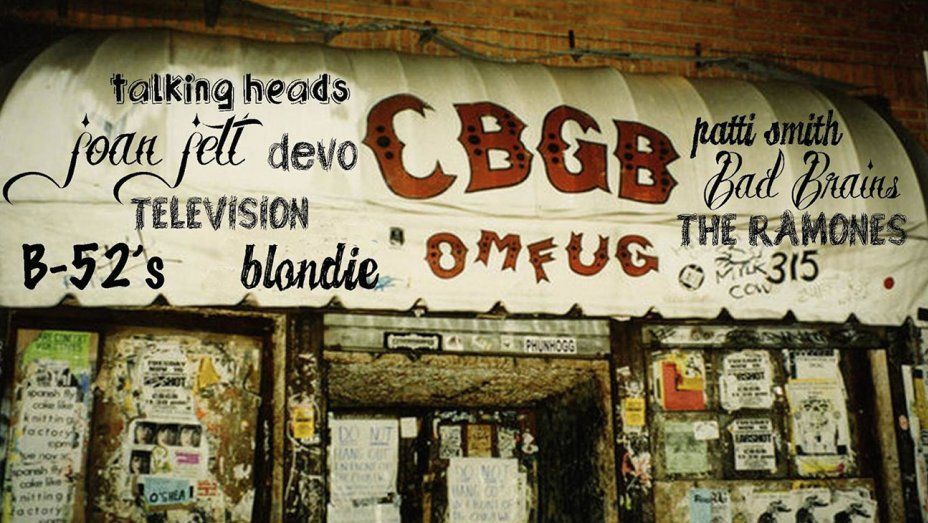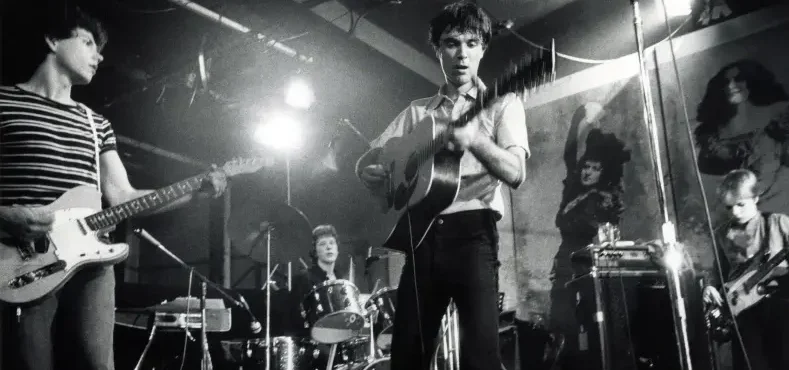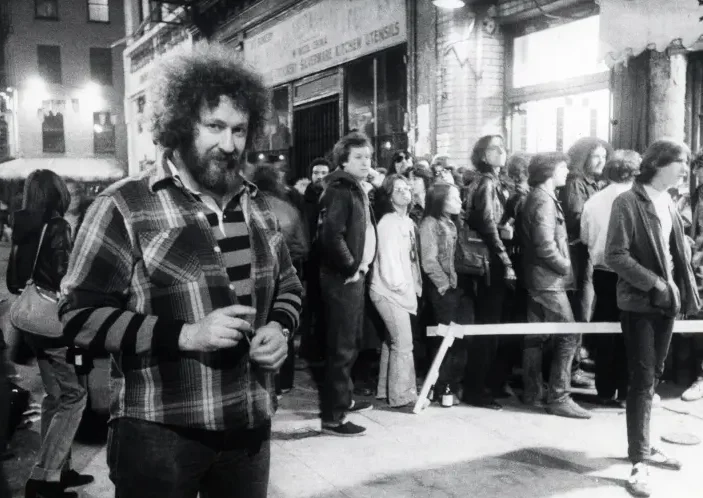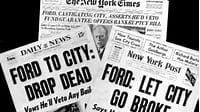New York’s New Wave Rocks the ’70s

CBGB & UMFUG stood for County, Bluegrass, Blues & Other Music for Uplifting Gourmandizers. The band names were added for this Hollywood Reporter graphic.
CBGB, Max’s Kansas City, and other iconic music emporiums launch New York’s ’70s punk rock/new wave revolution.
This ain’t no party, this ain’t no disco,
This ain’t no fooling around,
This ain’t no Mudd Club or CBGB,
I ain’t got time for it now.
–Talking Heads, “Life During Wartime,” 1979
from the album Fear of Music
CBGB
It is said that CBGB, the notorious music venue in the Bowery in lower Manhattan, became the bedrock for the ripening New York City punk rock/new wave scene in 1974 when Richard Lloyd of the band Television convinced owner Hilly Kristal to hire them for a Sunday night residency.
Or maybe it was when punk icons the Ramones made their first public appearance as a foursome in August 1974. (One witness remembered, “They were all wearing black leather jackets. They counted off this song and it was just a wall of noise.”) Or perhaps it was in August 1975 when the Talking Heads unveiled their fabled “Psycho Killer” and backup Blondie kicked off the night with the Motown romp, “Heatwave.”
And who could forget Patti Smith’s first appearance at CBGB on March 23, 1975, the soon-to-be queen of underground rock?
Hilly Kristal
Years before he offered Television the Sunday residency, Hilly Kristal was already a player in New York’s music scene by running the renowned Village Vanguard, which was (and still is) an important jazz and blues mecca. But Hilly yearned for a club to call his own, so in 1973 he opened Hilly’s On the Bowery, which in turn became CBGB & OMFUG to signal what music it would play and for whom (Country, Bluegrass, and Blues & Other Music for Uplifting Gourmandizers).
In those early days, CBGB became the site for young, untried talent who showed little interest in playing county, bluegrass, or blues as the owner envisioned. So Hilly Kristal took a flyer on local bands who played stripped-down rock ‘n’ roll with defiant intensity and at uncompromising high volume. Kristal had just one ironclad policy: “You have to do your own music.”
Soon, more and more young musicians congregated at the club at 315 Bowery, like Debby Harry, then with the Stilettoes, Johnny Thunders of the New York Dolls and the Heartbreakers, and Richard Hell, who had left Television to form the Voidoids. Reputations honed at CBGB provided many bands with record deals, beginning with Patti Smith’s 1975 Horses.
The Sounds of Manhattan
Exiting from the rock-dominated ’60s, the New York music scene was ready for a change. Already, primitive strains of disco, hip-hop, glam, punk, reggae, and “new age” jazz were percolating in nightclubs and garages all over the five boroughs.
This diversity, according to Rolling Stone, “comes from New York’s role as an international crossroads…a conduit for unassimilated third work cultures and the undisputed arts center of the country.”
What rock band would epitomize the transition from the psychedelic ’60s to the stylized, decadent, minimalist cabaret culture that emerged in the Big Apple at the dawn of a new decade?
The Velvet Underground and Lou Reed
That band was the Velvet Underground, with Andy Warhol’s “traveling mixed-media circus” in tow. With Lou Reed as lead singer, the Velvet Underground heralded:
The rebirth of rock primitivism and rock minimalism…twangy and raw and deliberatively monolithic of beat, marked by Reed’s quavering vocalizing that sounded almost intuitively out of tune…It proved that technical amateurishness and deliberate simplicity were no barrier to artistic communication.
–Rolling Stone
The Velvet Underground broke up in 1970 and a solo Lou Reed shifted to more conventional “art-rock” with the 1973 release of Berlin. However, the band’s sound was transformative to many young musicians making their start in the Big Apple. They would form the nucleus of New York’s mid-’70s punk rock/new wave revolution.
The Bands
The stars of New York’s new wave renaissance starting in the mid-’70s should be very familiar. The New York Dolls can claim to be the Velvet Underground’s heir apparent, adding glam-rock decadence and “pouting androgyny.” There were the aforementioned Television (“Marquee Moon,” 1977), the Ramones (“I Wanna Be Sedated,” 1978), and Patti Smith (“Gloria,” 1976). There were Blondie (“Rip Her to Shreds,” 1977), Joan Jett (“I Love Rock ‘n’ Roll,” 1979), and Dead Boys (“Sonic Reducer,” 1977). And there were Talking Heads.

Talking Heads (left to right, Jerry Harrison, Chris Frantz, David Byrne, and Tina Weymouth) perform at CBGB in 1977. Photo by David Godlis
Talking Heads
David Byrne, Chris Frantz, and Tina Weymouth became friendly at the Rhode Island School of Design. They moved to New York and formed as a trio in 1975 (Harvard alum Jerry Harrison was added in 1977). Their first gigs as Talking Heads (not “the”) were at CBGB in the summer of 1975.
Talking Heads’ music stretched the boundaries of conventional punk rock. Rolling Stone: “[They] were intrigued by the rhythms and spirit of Black music. They drew on funk, classical minimalism, and African rock to create some of the most adventurous, original, and danceable music to emerge from new wave.”
Talking Heads’ first single was “Psycho Killer,” from their first album, Talking Heads: 77. Here is a rough-cut video of the band performing “Psycho Killer” at CBGB in December 1975, good background material from publisher and narrator PRX via YouTube:
The Clubs
Here are other notable New York clubs that promoted punk rock/new wave music:
Max’s Kansas City
Opening in 1965 in the Gramercy section of lower Manhattan, the club quickly became a hangout for artists and sculptors in the New York School. Andy Warhol’s studio was right around the corner, so Andy and his entourage were regulars in Max’s infamous “back room.” Deborah Harry was once a waitress there. The club closed in 1981.
Mudd Club
The Tribeca-based Mudd Club was hopping from 1978 to 1983. It was purportedly named after Samuel Mudd, the doctor who treated assassin John Wilkes Booth. Besides the “This ain’t no Mudd Club or CBGB” Talking Heads reference, the Ramones’ “The Return of Jackie and Judy” shouted out, “Jackie is a punk, Judy is a runt, they went down to the Mudd Club and they both got drunk.”
Harrah
Known as the first “rock disco,” Harrah was a midtown Manhattan new wave fixture from 1976 to 1981. Hurrah pioneered the use of music videos to accompany its trio of famous DJs. The club became known for featuring Britsh punk bands’ first American performances.
Top 10 Playlist:
New Wave Wonders
Venus, Television
Dance This Mess Around, the B-52s
Rock ‘n’ Roll High School, the Ramones
Blank Generation, Richard Hell & the Voidoids
Bad Reputation, Joan Jett
All Mixed Up, the Cars
Trash, New York Dolls
Hanging on the Telephone, Blondie
Minor Threat, Minor Threat
What Difference Does It Make? the Smiths




















































































































